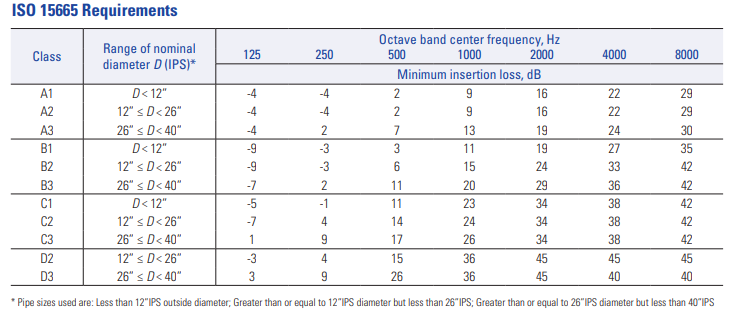Noise control in industrial facilities is a common concern. Large, loud machinery commonly found operating in industrial facilities can make it difficult to meet the occupational noise exposure limitations and recommendations established by OSHA, NIOSH and state agencies. Since each facility is responsible for ensuring OSHA compliance and auditory safety at their own facility, it is critical to understand how to effectively utilize insulation to mitigate unwanted noise. This is why the International Organization for Standardization (ISO) developed a standard that measures the acoustical performance of insulation and jacketing systems, ISO 15665.
ISO 15665 is an international standard that defines a test method for measuring the acoustical performance of installed and jacketed pipe insulation systems. The standard measures insertion loss for various configurations of insulation and jacketing on pipe systems. System designers need to keep in mind that ISO 15665 applies only to pipe systems; it does not apply to rectangular ducts or equipment.
The standard defines acoustical performance in three different Classes:
- Class A (least robust ISO class)
- Class B
- Class C (most robust ISO class)
A fourth, even more stringent Class, Class D, was created by a major petrochemical company to help ensure the insulation systems they install at their facilities meet their highly stringent acoustical control requirements. Class D is the most difficult Class for an insulation/jacketing configuration to meet.
Each Class has three subclasses (1, 2, and 3) that represent pipe size categories. These read as Class A1, Class A2, Class A3, etc. The subclasses help system designers determine how well an insulation/jacketing configuration will control noise on a specific pipe size. This allows them to specify a particular configuration for the unique requirements of the pipe size in their applications.
The ISO 15665 subclass pipe size diameters are split into the following categories:
- Category 1: Pipes < 12” (300 mm) IPS
- Category 2: Pipes > 12” (300 mm) to <26” (650 mm) IPS
- Category 3: Pipes > 26” (650 mm) to < 40” (1000 mm) IPS
The larger the pipe size, the more difficult it is to pass the ISO 15665 test. As a result, configurations that meet the Category 3 tend to have more robust insulation and jacketing configurations than what is required for Categories 1 and 2.
In order to receive a Class rating, ISO 15665 establishes a specific set of insertion loss requirements the system configuration must meet at specified octave bands. The larger the pipe size, the more difficult it is to meet the insertion loss requirements of ISO 15665. The table below outlines the minimum insertion loss requirements of the ISO 15665 standard for each Class and pipe size.
In many cases (at many frequencies), a configuration that meets a higher Class will also meet the Classes preceding it (e.g.: A Class C3 configuration often also meets Class A and Class B requirements). This is not always the case, however, so system designers should carefully consider both the ISO 15665 requirements as well as the performance of the unique system they specify before making an extrapolation down in pipe size or class.
Johns Manville is currently the only insulation manufacturer that has tested a configuration using that meets the Class D3 requirements – the most stringent and difficult requirements established using the ISO 15665 test method. JM also has pipe system assemblies that meet other Class requirements (specifically A2, A3, B3, and C3). This allows system designers to select the optimal configuration for the unique requirements of the applications at their facilities. Each tested configuration uses MinWool-1200® Pipe insulation, mass loaded vinyl (MLV), and metal jacketing.
We will be taking a detailed look at these configurations, using, in our upcoming Insulation Intel® webinar, Industrial Noise Control: Strategies for Acoustical Insulation.


